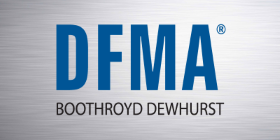DFMA Case Study: Flashlight Redesign Saves Millions
DFMA Case Study: Flashlight Redesign Saves Millions
Firefighters operate under dark, dusty, and often smoky conditions where visibility is poor and the air may be filled with numerous floating particles. It’s crucial that their equipment functions well in these hazardous environments, but it must also be affordable enough for government agencies to invest in.
A major manufacturing company decided to redesign its firefighter flashlight to make it more cost-effective and easy to produce. In the process, the company saved millions using DFMA software.
The team made a special effort to reduce part counts, simplify manufacturing and assembly processes, and eliminate complex processes such as adhesive bonding and soldering, which can be time-consuming and prone to mistakes.
Methods
They achieved their goals by following DFMA principles as they redesigned the flashlight from scratch. They began by evaluating which parts were needed for the product. They asked themselves:
- Does each part move in relation to other parts during service or operation?
- Do parts need to be made from different materials?
- Must parts be disassembled to put the product together or during servicing?
The answers to questions such as these enabled them to calculate the efficiency of each part and process. From there, each component’s efficiency could be improved upon until the finished product was a vastly improved version of the original.
Results
Part Count Reduction
The company achieved a remarkable 67% reduction in parts used to build the flashlight using DFMA software. The original design required 30 individual parts; the redesign required only 10.
Simplifying the design and construction of the flashlight was a top priority, since reducing component count usually translates to significant savings in mass-produced products. Using fewer parts resulted in less inventory to stock, a simpler supply chain, and less complex assembly operations.
Assembly Time Reduction
The company drastically reduced product assembly effort and time by simplifying the flashlight’s structure and optimizing its components. The redesign efforts resulted in a 60% reduction in assembly time for the finished product.
Reducing assembly time to less than half of what it had been lowered labor costs, increased production and product output, and significantly improved overall operational efficiency.
Streamlined Manufacturing Processes
By implementing DFMA principles, the company reduced the manufacturing processes required to complete each flashlight by a staggering 69%.
The original product needed 16 separate manufacturing processes, whereas the new model required only five. Processes were also simpler, which meant the assembly process was not only quicker but also much easier. This reduced manufacturing costs directly, eliminated a few potential failure points, and improved the consistency and quality of the final product.
Want to see what DFMA software could do for you?
You, too, could redesign a product and save your company countless hours and significant costs. Contact us, and we’ll help you get started.




